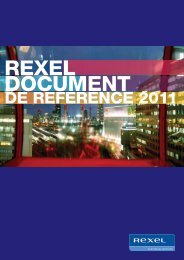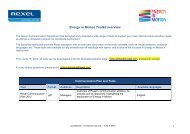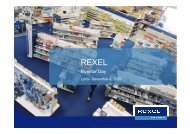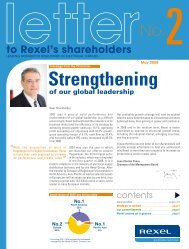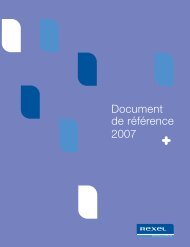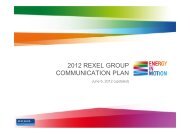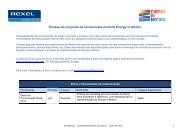2008 Registration Document - Rexel
2008 Registration Document - Rexel
2008 Registration Document - Rexel
You also want an ePaper? Increase the reach of your titles
YUMPU automatically turns print PDFs into web optimized ePapers that Google loves.
at balance sheet date, less the estimated selling expenses,taking into account technical or marketing obsolescenceand risks related to slow moving inventory.2.9 Investments2.9.1 Long-term investmentsLong-term investments principally include investments innon-consolidated companies and other shareholdings,deposits required for operating purposes, and loans.Investments in non-consolidated companies and othershareholdings are classified as assets available-for-saleand measured at fair value. When fair value is not reliablymeasurable, investments are stated at cost less impairmentlosses when necessary. Changes in fair value are recognizedin equity and transferred to profit or loss when the asset issold or permanently impaired.2.9.2 Held for trading instrumentsFinancial instruments held for trading mainly includemarketable securities and are stated at fair value, with anyresulting gain or loss recognized in profit or loss.The fair value of financial instruments classified as held fortrading is their quoted bid price at the balance sheet date.Change in fair value is recognized in profit or loss.2.9.3 Trade and other accounts receivableTrade and other accounts receivable are measured initiallyat fair value and subsequently measured at amortized costusing the effective interest rate method (see note 2.12) lessimpairment losses.Impairment losses from estimated irrecoverable amountsare recognized in the income statement when thereis objective evidence that the asset is impaired. Theprincipal factors considered in recognizing these potentialimpairments include actual financial difficulties or aging ofoverdue receivables in excess of 30 days.2.9.4 Derivative financial instrumentsDerivative financial instruments that qualify for hedgeaccounting according to IAS 39 are classified as hedges.The derivative financial instruments that do not qualifyfor hedge accounting, although set up for the purposeof managing risk (the Group’s policy does not authorizespeculative transactions), are designated as and accountedfor as trading instruments.Derivative financial instruments are measured at fairvalue. The gain or loss on remeasurement to fair value isrecognized immediately in profit or loss. However, whenderivatives qualify for hedge accounting, the recognition ofany resulting gain or loss is dependent on the nature of theitem being hedged (see note 2.9.5). They are counted asassets or liabilities depending on their fair value.Interest rate & foreign exchange risksThe Group uses derivative financial instruments to hedge itsexposure to foreign exchange and interest rate risks.In accordance with Group procedures, derivative financialinstruments are not used for speculative purposes. However,derivatives that do not qualify for hedge accounting areaccounted for as trading instruments.Fair value estimatesThe fair value of financial instruments traded in activemarkets (such as publicly traded derivatives and securities)is based on quoted market prices at the balance sheetdate. The quoted market price used for financial assetsheld by the Group is the current bid price; the appropriatequoted market price for financial liabilities is the currentask price.The fair value of financial instruments that are not traded inan active market (for example, over-the-counter derivatives)is determined by using valuation techniques. The Groupuses a variety of methods and makes assumptions that arebased on market conditions existing at each balance sheetdate. Quoted market prices or dealer quotes for similarinstruments are used for long-term debt. Other techniques,such as estimated discounted cash flows, are used todetermine fair value for the remaining financial instruments.The fair value of interest-rate swaps is calculated as thepresent value of the estimated future cash flows. The fairvalue of forward foreign exchange contracts is determinedusing forward exchange market rates at the balance sheetdate.2.9.5 Hedge accountingCash flow hedgesWhen a derivative financial instrument is designated as ahedge of the variability in cash flows of a recognized assetor liability, or a highly probable forecasted transaction,the effective part of any gain or loss on the derivativefinancial instrument is recognized directly in equity. Whenthe forecasted transaction subsequently results in therecognition of a non-financial asset or non-financial liability,the associated cumulative gain or loss is removed fromequity and included in the initial cost or other carryingamount of the non-financial asset or liability. If a hedgeof a forecasted transaction subsequently results in therecognition of a financial asset or a financial liability, thenthe associated gains and losses that were recognizeddirectly in equity are reclassified into profit or loss in thesame period or periods during which the asset acquiredor liability assumed affects profit or loss (i.e., when interestincome or expense is recognized).For cash flow hedges, other than those covered by the twopreceding policy statements, the associated cumulativegain or loss is removed from equity and recognized inprofit or loss in the same period or periods during whichthe hedged forecast transaction affects profit or loss. Theineffective part of any gain or loss is recognized immediatelyin profit or loss.When a hedging instrument expires or is sold, terminatedor exercised, or the Group revokes the designation of thehedge relationship but the hedged forecast transaction isREXEL <strong>2008</strong> | PAGE 165





